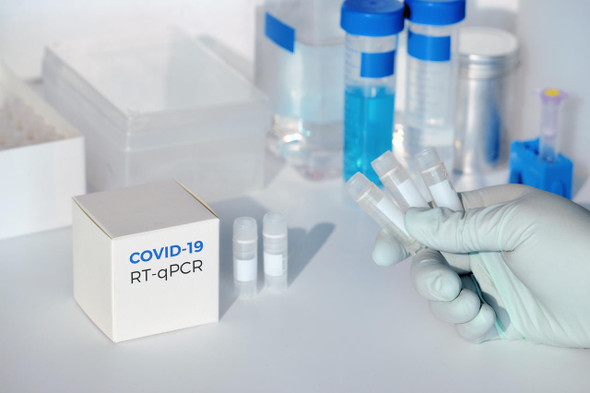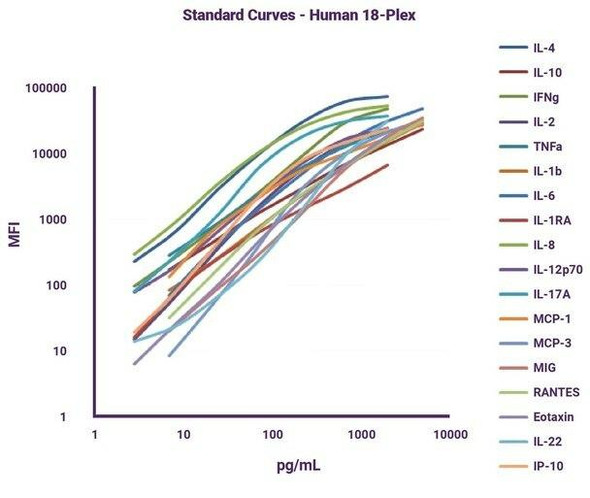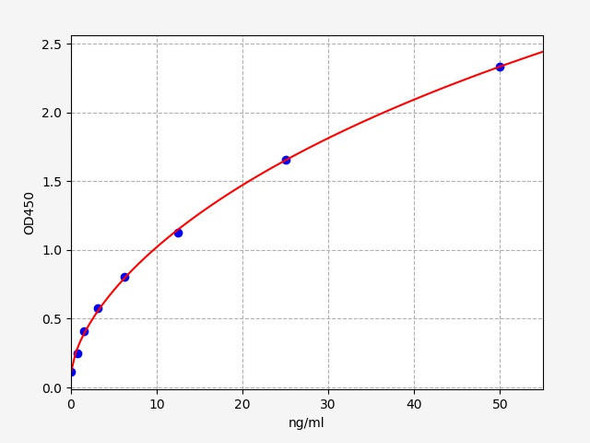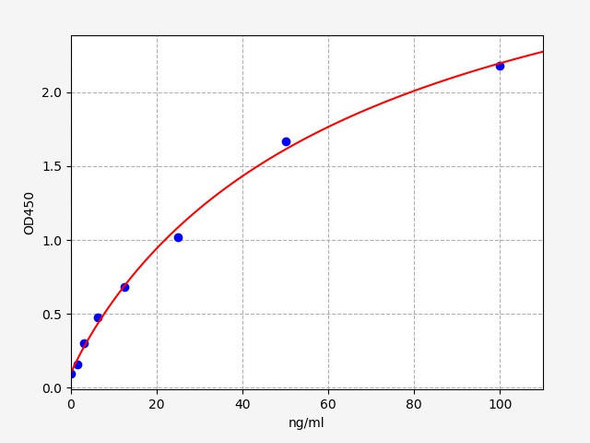COVID-19 (SARS-CoV-2) & Influenza A/B Multiplex QPCR Detection Kit
- SKU:
- VA0002
- Product Type:
- Biosimilar Antibody
- Antibody Type:
- Monoclonal Antibody
- Protein:
- CD37
- Isotype:
- IgG1
- Reactivity:
- Human
- Host Species:
- Chimeric
- Synonyms:
- CD37, TSPAN26, Tspan-26
Description
COVID-19 (SARS-CoV-2) & Influenza A/B Multiplex QPCR Detection Kit
This product is a multiplex reverse transcription quantitative real-time PCR (RT-qPCR) kit based on Taqman probe method. The 3' end of each detection probe is labeled with a quenching group, and the 5' end is labeled with a different reporter group. When the probe is intact, since the quenching group is close to the reporter group, the fluorescence emitted by the reporter group is absorbed by the quenching group, and no fluorescence signals are detected. When the primer is extended, the fluorescent probe bound to the template is cleaved by Taq enzyme (5'→3' exonuclease activity), the reporter group is separated from the quenching group, and fluorescence signals are generated. The fluorescent quantitative PCR instrument can automatically draw a real-time amplification curve based on the detected fluorescence signals, so as to realize the qualitative detection at the nucleic acid level. The multiplex RT-qPCR detection system also includes a pair of primers and probe for internal control, which can be used to monitor the sample collection, sample handling and RT-qPCR process to avoid a false-negative result.
Kit Components
|
Reagent Name |
Specification |
Main Ingredients |
Cap color |
|
Detection Buffer |
900 μL/ tube × 3 |
Buffer, dNTPs, Primers, Probes |
Red |
|
Enzyme Mix |
400 μL/ tube × 1 |
RNase Inhibitor, Taq DNA polymerase, Reverse Transcriptase, UDG |
Blue |
|
Positive Control |
250 μL/ tube × 1 |
RNA pseudovirus containing target genes |
Yellow |
|
Negative Control |
250 μL/ tube × 1 |
DEPC-Treated Water |
Green |
Note:
- Do not mix or exchange components from different lots.
- Self-prepared reagent: Nucleic acid extraction kit, such as nucleic acid extraction and purification reagent manufactured by Nanjing Vazyme Biotechnology Co., Ltd., nucleic acid extraction and purification reagent manufactured by Shanghai BioGerm
Medical Biotechnology Co., Ltd. and QIAamp Viral RNA Mini
Kit.
- The positive control and the negative control are used to monitor the entire detection process to avoid false negative or false positive results. Both of them need to carry out nucleic acid extraction at the same time as the sample to be tested.
Storage & Stability
- The kit should be stored at -20±5℃ and protected from light. The kit is valid for 12 months.
- Avoid repeated freezing-thawing (less than 10 freezing-thawing cycles).
- Please refer to the outer package for the manufacture and expiry date.
Method
- Sample processing (sample processing area)
The samples should be extracted according to the corresponding requirements and procedures of RNA extraction kits. Each nucleic acid extraction procedure must be performed simultaneously with a Positive Control (add 5 μL, dilute with sterile saline solutions to desired volume) and a Negative Control (add 5 μL, dilute with sterile saline solutions to desired volume). The extracted RNA can be directly used for detection. If the extracted RNA is not used for detection immediately, please store the RNA at below -70°C, avoiding repeated freezing-thawing.
- Reagent Preparation (Pre-PCR Preparation Area)
Thaw the required reagents. Mix by shaking, and centrifuge briefly before use. Prepare the mixture in a RNase-free centrifuge tube as follows:
|
Reagent Name |
Volume ( μL / Per Reaction) |
|
Detection Buffer |
26 |
|
Enzyme Mix |
4 |
|
Total Volume |
30 |
Mix the above mixture thoroughly, and make aliquots of 30 μL into different PCR reaction tubes. Then, move to the Specimen Preparation Area.
- Template Addition (Specimen Preparation Area)
Add 20 μL of extracted Negative Control products, 20 μL of extracted Positive Control products, and 20 μL of extracted RNA from specimen to different PCR reaction tubes which contained 30 μL of PCR mix. The final volume is 50 μL. Cap the reaction tubes tightly. Centrifuge the tubes at low speed. Then, move to the Detection Area. - RT-qPCR Amplification (Detection Area)
Put the reaction tubes on a PCR instrument, setup and run the following cycling protocol:
Recommended Procedure by Life Technologies QuantStudioTM 5:
|
Step 1 |
Reverse Transcription |
Cycle: 1 |
50℃ |
5 min |
|
Step 2 |
Pre-denaturati on |
Cycle: 1 |
95℃ |
30 sec |
|
Step 3 |
PCR Cycles |
Cycles: 40 |
95℃ |
5 sec |
|
58℃ (Collect Signal) |
10 sec |
Recommended Procedure by ABI 7500/SLAN-96P:
|
Step 1 |
Reverse Transcription |
Cycle: 1 |
50℃ |
5 min |
|
Step 2 |
Pre-denaturati on |
Cycle: 1 |
95℃ |
30 sec |
|
Step 3 |
PCR Cycles |
Cycles: 40 |
95℃ |
5 sec |
|
58℃ (Collect Signal) |
30 sec |
Settings of detection fluorescence: O gene and N gene (FAM); M gene (HEX/VIC); NP gene (TEXAS RED/ROX); Internal Control (CY5). Please set the fluorescence internal reference parameter of the instrument to "None". For example: for ABI series instruments, please set "Passive Reference" to "None"
- Data Analysis (refer to Instrument User Manual)
Take ABI7500 as an example: after the qPCR reaction, the results were saved automatically. According to the analyzed image, please adjust the Start value, End value, and Threshold value of the Baseline (Start value: 3 ~ 15; End value: 5 ~ 20; Threshold value could be set in the Log window, and the threshold line should be in the exponential phase of the amplification curve; the amplification curve of the Negative Control should be straight or below the threshold line). Click "Analysis" to obtain the analysis result automatically, and read the detection result in the "Report" window.
Quality Control
|
Channel |
Normal CT |
|
|
Negative Control |
FAM |
No CT or CT > 38 |
|
TEXAS RED/ROX |
No CT or CT > 38 |
|
|
HEX/VIC |
No CT or CT > 38 |
|
|
CY5 |
No CT or CT > 38 |
|
|
Positive Control |
FAM |
CT≤33 |
|
TEXAS RED/ROX |
CT≤33 |
|
|
HEX/VIC |
CT≤33 |
|
|
CY5 |
CT≤33 |
The result is valid if ALL the above criteria is met. Otherwise, the result is invalid.
Reference Range
Through the research on reference values, the CT reference value of target gene is determined to be 38, the CT reference value of internal control is determined to be 33.
Explanation of Detection Range
If the criteria of Quality Control is met, analyze the data of sample as follows:
|
*1. If the CT value of CY5 (Internal Control) channel is >33, it may indicate that the detected specimen contains lower concentration of cells, extracted nucleic acid was degraded or certain inhibitors were present in the reaction. *2. If the CT value of CY5 channel is ≤33, analyzing the results according to the following table: |
|
|
Explanation of Detection Result |
|
|
Positive |
FAM Channel CT ≤38 |
|
Positive |
HEX/VIC Channel CT≤38 |
|
Positive |
TEXAS RED/ROX Channel CT≤38 |
|
Negative |
FAM, HEX/VIC, TEXAS RED/ROX channel CT>38; CY5 channel CT≤33. |
*No requirement for CY5 channel test results, if the sample is extracted from culture.
Limitations of Detection Range
- The detected target sequences of this products are the conserved sequence of O gene, N gene, M gene and NP gene. However, target sequence variations may lead to false negative result.
- Cross contamination during specimen treatment may lead to false positive result.
Notes
- This product is only for research use, and this manual shall be read carefully before the experiment.
- The test samples should be considered as infectious substances. Operation and handling must comply with the relevant requirements of local laws and regulations.
- Product treatment: After PCR, due to that the product is easy to cause pollution, all reaction tubes shall be put into waste disposal bags or other containers for biosafety by the personnel who will no longer participate in the experiment on the same day. In addition, confirm that they are completely closed before being discarded.
- RNase pollution shall be avoided in the whole process. Work clothes, disposable gloves and masks shall be worn during the experiment. Operation shall be completed in the chemical ventilation cabinet or biosafety cabinet with clean disinfection and ultraviolet sterilization to avoid harmful substances entering the respiratory tract.
- Disposable centrifuge tubes and tips by autoclaved sterilization shall be used. Centrifuge tubes and tips without DNase and RNase shall be purchased.
- The PCR detection reagent shall be completely thawed before use and used after centrifugation at 8,000 rpm for several seconds. In addition, repeated freezing and thawing shall be avoided.
- If cross contamination is happened during sample treatment, it may results in false positive results.
- The laboratory management shall be in strict accordance with the management regulations of PCR gene amplification laboratory. The laboratory personnel must be trained professionally and the experiment shall be strictly carried out in partitions (pre-PCR preparation area, sample treatment area and detection area). All consumables shall be disposable after sterilization. Special instruments and equipment shall be used in each stage during experimental operation, and the supplies in various stages of various areas shall not be cross-used.
- After the experiment, 10% hypochlorous acid or 75% alcohol shall be used to treat the worktable and pipette, and ultraviolet lamp shall be used to irradiate for 20-30 min.
- After nucleic acid extraction of the sample, it is recommended to carry out the next step immediately. Otherwise, it shall be kept at -20°C for use (within 24 hours).
- Quality control shall be performed for each experiment.
- During reagent storage, transportation and use, many factors may cause performance changes, such as improper storage and transportation as well as improper sampling, sample treatment and detection operation. Therefore, operation shall be carried out in strict accordance with the instructions. Due to the characteristics of swabs, there may be false negative results caused by insufficient sample collection.










